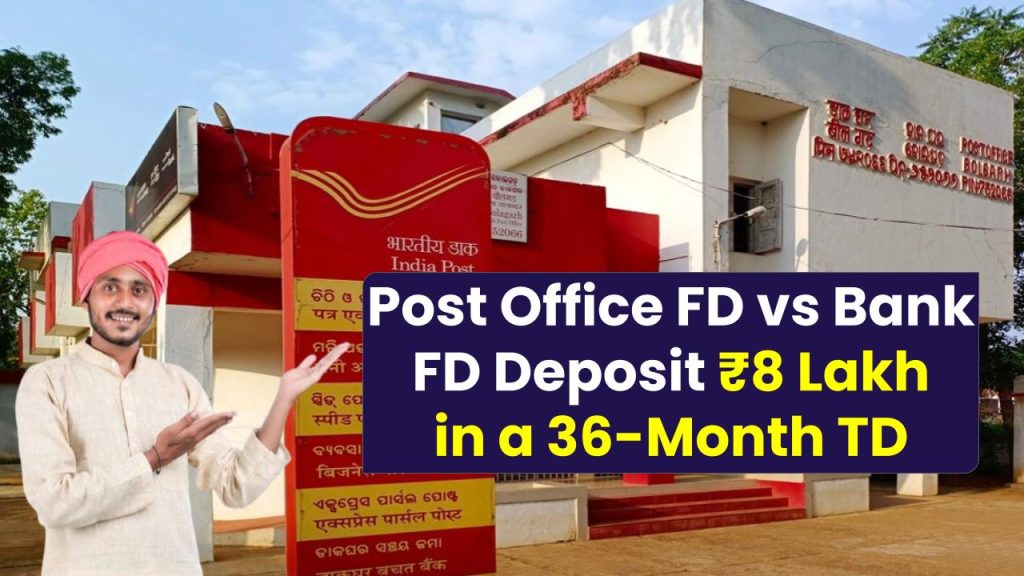
If you’re looking for a safe and guaranteed return on your ₹8 lakh investment, you’re probably comparing Post Office Fixed Deposits (FDs) with Bank Fixed Deposits. One of the most searched queries today is: “If I invest ₹8 lakh in a 36-month Post Office Time Deposit (TD), how much will I get back on maturity?”
Post Office FD vs Bank FD
| Particulars | Post Office TD (36 Months) | Bank FD (36 Months, SBI Example) |
|---|---|---|
| Investment Amount | ₹8,00,000 | ₹8,00,000 |
| Interest Rate | 7.1% p.a. (compounded quarterly) | 6.50% p.a. (compounded quarterly) |
| Maturity Period | 3 Years | 3 Years |
| Maturity Amount | ₹9,85,152 (approx.) | ₹9,66,129 (approx.) |
| Interest Earned | ₹1,85,152 | ₹1,66,129 |
| Taxability | Interest is taxable | Interest is taxable |
| Safety | Backed by Government of India | Covered up to ₹5 lakh by DICGC |
If you’re planning to invest ₹8 lakh for 3 years, a Post Office FD (TD) is clearly the winner with higher returns and unmatched safety. It’s ideal for conservative investors, senior citizens, and anyone seeking guaranteed returns without market risk. With a return of nearly ₹1.85 lakh, this scheme is not only simple to invest in but also smart in today’s volatile times.
What is a Post Office Fixed Deposit (Time Deposit)?
A Post Office Time Deposit (TD) is a government-backed savings instrument offered by India Post. It works much like a bank FD but offers better interest rates, especially for 1 to 5-year tenures.
The best part? Zero risk. Your money is backed by the Government of India, unlike banks where deposits are only insured up to ₹5 lakh under the DICGC (Deposit Insurance and Credit Guarantee Corporation).
How Much Will You Get for ₹8 Lakh in 3 Years?
Let’s do the math.
- Interest Rate (3-Year TD): 7.1% p.a. (as of Q1 FY 2025-26)
- Compounding: Quarterly
- Principal: ₹8,00,000
- Time: 3 years
Using the compound interest formula:
Maturity Amount = P × (1 + r/4)^(4×n)
Where:
- P = ₹8,00,000
- r = 0.071 (7.1%)
- n = 3
Maturity = ₹8,00,000 × (1 + 0.071/4)^12 ≈ ₹9,85,152
Total Interest Earned = ₹1,85,152
see also: PNB FD Interest Rate 2025: Punjab National Bank Changed the Rates
Post Office FD vs Bank FD: Which Is Better for ₹8 Lakh Investment?
Let’s compare with SBI, India’s largest public sector bank:
SBI 3-Year FD (Regular Citizens)
- Interest Rate: 6.5% p.a.
- Maturity Amount: ₹9,66,129 (approx.)
- Interest Earned: ₹1,66,129
Summary: Post Office FD wins with ₹19,000+ higher returns over 3 years for the same amount.
Why You Should Consider Post Office TD Over Bank FD
1. Higher Returns
As seen, Post Office TD offers better rates than most leading banks. For 3 years, it gives 7.1%, while SBI offers only 6.5%.
2. Risk-Free Backing
Bank FDs are insured up to ₹5 lakh. But the Post Office is 100% government-backed, making it one of the safest investments in India.
3. Flexible Tenures
You can choose between 1, 2, 3, or 5-year TDs. Interest is compounded quarterly and paid annually.
4. Easy to Open
Available at India Post branches and now even via IPPB mobile app for some services.
How to Open a Post Office Time Deposit (TD) Account
Here’s a quick guide:
Step 1: Visit Your Nearest Post Office
Carry the following documents:
- Aadhaar Card
- PAN Card
- Passport-sized photo
- Initial deposit (cash/cheque/DD)
Step 2: Fill Form A
This is the Post Office TD Account Opening Form. Specify the amount, tenure (36 months in this case), and nominee details.
Step 3: Submit KYC Documents
As per RBI norms, KYC is mandatory.
Step 4: Get Passbook
Once the account is opened, you will receive a passbook detailing your deposit.
Tax Implications on Post Office FD
- Interest earned is taxable under “Income from Other Sources”.
- No TDS is deducted by the Post Office, but you must declare the income in your ITR.
- If you’re a senior citizen, Section 80TTB lets you claim up to ₹50,000 exemption on FD interest.
Pro Tip: You can submit Form 15G/15H (if eligible) to avoid tax deduction.
How to Calculate Maturity for Any FD (Bank or Post Office)
Use this compound interest formula:
M = P × (1 + r/n)^(n×t)
Where:
- M = Maturity amount
- P = Principal
- r = Annual interest rate (decimal)
- n = Compounding frequency (quarterly = 4)
- t = Time (in years)
Real-Life Example: Which Option is Better?
Imagine you’re Ravi, a 40-year-old professional looking to invest ₹8 lakh safely for 3 years.
| Option | Return | Risk | Liquidity |
|---|---|---|---|
| Post Office TD (7.1%) | ₹1,85,152 | Zero (Govt-backed) | Medium |
| SBI Bank FD (6.5%) | ₹1,66,129 | Low (insured up to ₹5 lakh) | High |
Ravi chooses the Post Office TD. Why? He gains nearly ₹19,000 more without any risk.
see also: Savings vs Investing: Know How Much You Should Save and How Much You Should Invest
Post Office FD vs Bank FD FAQs
Q1. Is Post Office TD better than Bank FD?
Yes, especially in terms of interest rates and safety. Post Office TDs are backed by the government.
Q2. Can I break a Post Office TD before maturity?
Yes, after 6 months, but the interest will be lower. Premature withdrawal terms apply.
Q3. Is interest from Post Office FD tax-free?
No, it is taxable. But there is no TDS deducted by the Post Office.
Q4. Can I open a Post Office FD online?
You can access services through IPPB mobile app, but new TD accounts must be opened at the Post Office branch.
Q5. What happens after the FD matures?
You can renew the TD, withdraw it, or transfer it to your Post Office savings account.











